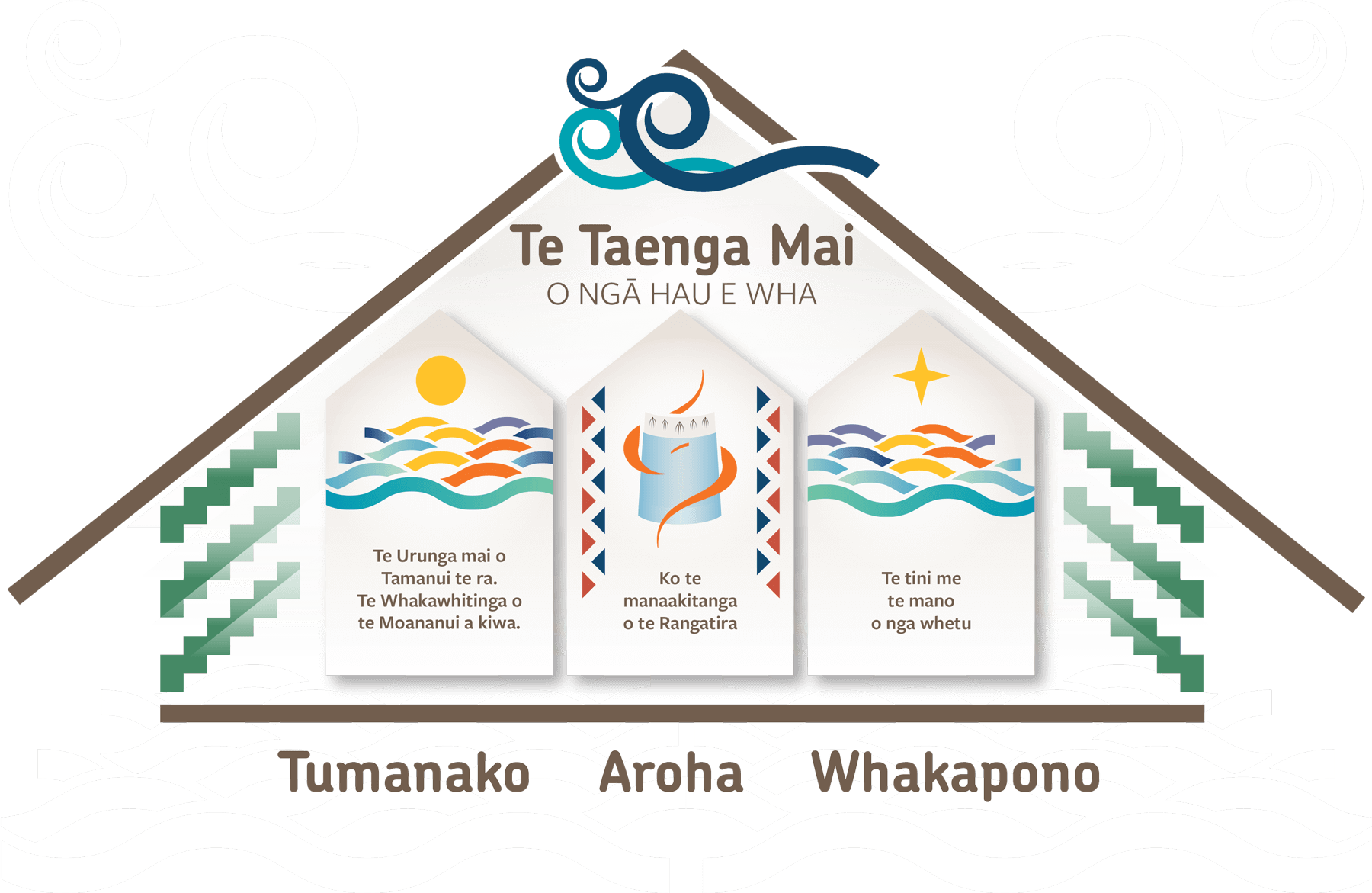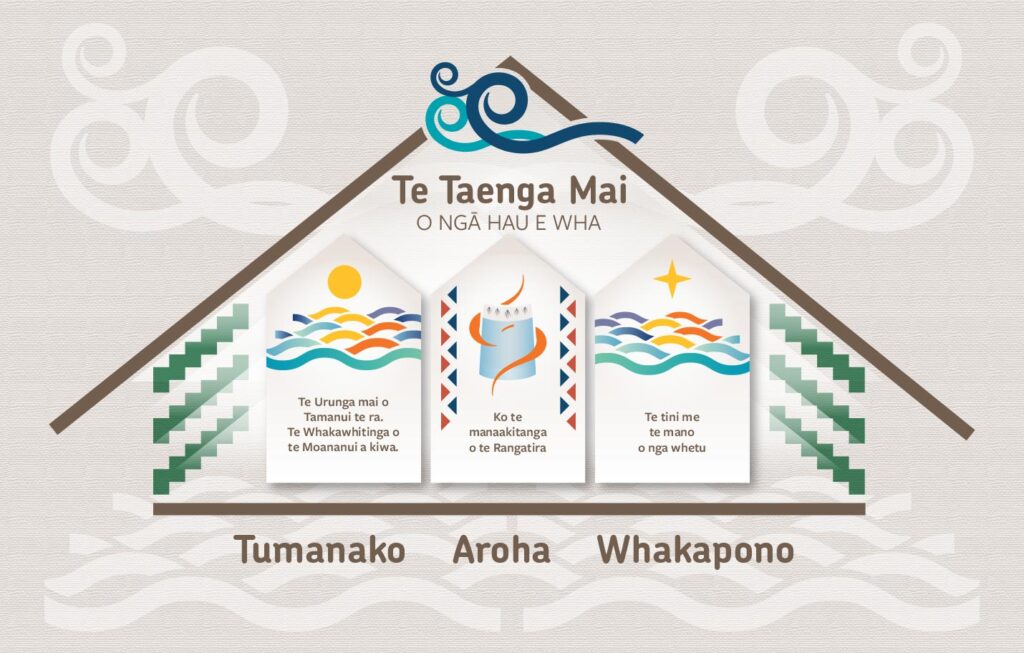Tawhirimatea in Māori mythology is the God of Wind. As Tawhirimate circulates and gathers momentum he also gathers those who are looking for change, those looking to better their lives. They embark on their journey with Tawhirimatea who carries them to their destination, therefore in this instance to Aotearoa. Te Taenga mai o nga hau e wha.
For Māori it is an unconditional process that is intrenched in our very being. We are one with the taiao and the taiao is one with us. If there is a disconnect then it’s about the individual not the process. Why a Māori model of practice? To keep the connection to oneself, to one another to everything around us te taioa.
Pages in this section:
Te taenga mai o nga hau e wha — The arrival of the four winds
Mai nga hau e wha in this context means ‘of the four winds. Te taenga mai o nga hau e wha is our model of practice referring to those who have left their birth land and have travelled the oceans arriving in Aotearoa New Zealand, making it their home. The three symbols that sit in the centre of this model represents the challenges, the trials and tribulations, of their journey.
Click on the pulsing circles below to read about each aspect of our model of practice.

Te Urunga mai o Tamanui te ra. Te Whakawhitinga o te Moananui a kiwa.
Symbol one depicts the rising of the sun as its rays glisten over the seas of Kiwa. Kiwa (an ancestor of the He Rangatira) who himself has been said to travel the seas of Kiwa. This symbolises the journey of refugee, migrants and asylum seekers who have taken the same journey as Kiwa.
Close
Ko te manaakitanga o te Rangatira.
The korowai, or the cloak, symbolises manaakitanga, the epitome of human existence. Manaakitanga embraces all things with respect and integrity. Giving and receiving of manaakitanga ensures harmonical balance. We are all Rangatira in our own right and of our own life’s journey. It embodies concepts of hospitality, kindness, generosity, care and support.
Close
Te tini me te mano o nga whetu.
Symbol three makes reference to the multitude of stars that glistens in the night sky of Matariki. From the North, South, East and West, from the four corners of the world to arrive here in Aotearoa making it their home.
Close
Poutama
The Poutama known as the ‘Stairway to heaven’ used in this Māori model of practice refers to the levels of which we live life. Each step is the level of each stage of our journey. What happens on those levels, determine where we end up in life and the choices that we make.
Close
Poutama
The Poutama known as the ‘Stairway to heaven’ used in this Māori model of practice refers to the levels of which we live life. Each step is the level of each stage of our journey. What happens on those levels, determine where we end up in life and the choices that we make.
Close
Kaokao
The Kaokao depicted in this Māori model of practice sits on either side of the korowai. This symbolises strength, and power. This is what is needed when one embarks on a life changing journey.
Close
The model of practice is founded on the values of Tumanako, Aroha and Whakapono.
Tumanako – One’s hopes and aspirations
Tumanako are one’s hopes, aspirations, wants, desires. This is the drive that many including refugees, asylum seekers, and migrants choose to come to Aotearoa in search of a better life trusting in the choice they have made.
Close
The model of practice is founded on the values of Tumanako, Aroha and Whakapono.
Aroha – Love
Unconditional sharing and giving without a second thought is the extension of Aroha. Sharing the breath of life, to give unconditionally to each other and ‘te taiao’ (our surroundings). Giving and showing respect for the people of this land Tangata whenua their values and traditions / practices.
Love is the catalyst for true and honest collaboration, change, development, and achievement. This can demonstrate care and compassion to each other and the world around us.
Close
The model of practice is founded on the values of Tumanako, Aroha and Whakapono.
Whakapono – To believe, to trust
Belief gives us direction and focus. Believe in yourself, your ability to accomplish and achieve. Believe in your values and life’s purpose. This is not just about an individual it is also about the collective and about the process.
Trust in yourself, trust the process, trust that you are understood, and you understand others. Trust and believe in your insights, your strengths and weaknesses.
Close
Whare
A whare (house), signifying shelter, safety and welcome. For Māori, Whare can also signify each person in the whare and wellbeing of that person. Whare within this model of practice is signifying a large community of migrants, refugees & asylum seekers in Aotearoa.
Close
Koru
The three koru signify different generations, children, parents and grandparents, representing family, and ancestors from the past, the present and the future.
Close
